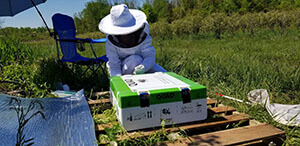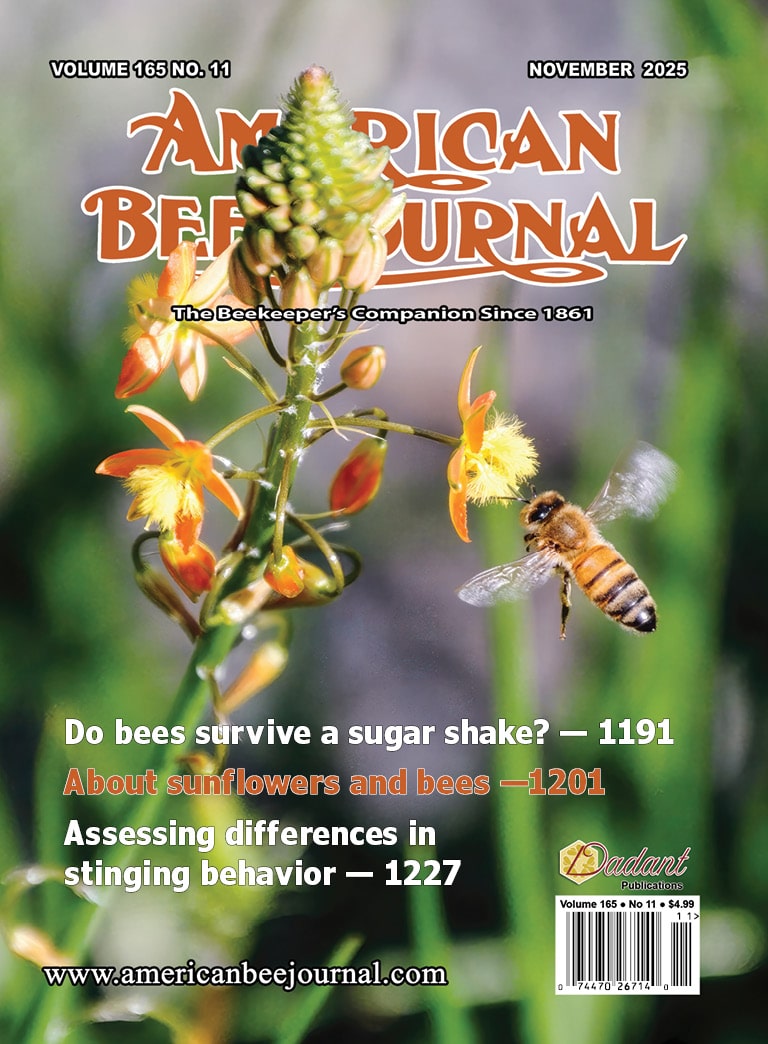Notes from the Lab
Notes from the Lab – July 2022

Harmful pesticide exposures during crop pollination come from beyond the farm
As I write this, it’s currently pollination season throughout the northern U.S., which means lots of beekeepers are bringing lots of bees to lots of farms. In New York, pollination is worth ~$400 million per year to the state’s fruit and vegetable farmers. In other words, this annual early-summer movement of pollinators isn’t just a curiosity, it’s vital to the economy. And that means it’s in everyone’s best interest to make sure that bees, our main agricultural pollinators, aren’t exposed to harmful pesticides while performing their pollination services.
We know that bees are almost always exposed to pesticides during crop pollination. For example, a recent analysis of bee-collected pollen during Michigan blueberry pollination season found that honey bee colonies are simultaneously exposed to 35 pesticides, on average (Graham et al. 2021). Managed bumble bees fare a bit better and are exposed to 19 pesticides, on average. That’s still quite a few pesticides!
The important question is this: Are pesticide exposures during crop pollination dangerous, or are they simply trace amounts of contaminants that are unlikely to impact bee health? Perhaps more importantly, if some harmful exposures do occur, where do they come from? If we understand the sources of high-risk exposures, we can work to reduce exposures from those sources in the future. These are the topics for the fifty-fifth Notes from the Lab, where I summarize “Pesticide risk to managed bees during blueberry pollination is primarily driven by off-farm exposures,” written by Kelsey Graham and colleagues and published in the journal Scientific Reports [2022]. Full disclosure: I am a co-author on this study.
For their study, Graham and colleagues focused on two species of bees used for commercial blueberry pollination (Photo 1) in Michigan and elsewhere, the Western honey bee (Apis mellifera) and the common Eastern bumble bee (Bombus impatiens). To measure the magnitude and sources of pesticide risk, the authors first sampled bee-collected pollen from multiple honey bee and bumble bee colonies at highbush blueberry farms during peak bloom. Pollen from honey bees was sampled in each of two years from 21 fields that were managed using conventional pest management, organic pest management, or no chemical pest management at any time of the year. Pollen from bumble bees was sampled at 15 fields in the second year of the study at conventional or unsprayed farms (Photo 2). Blueberry flowers, foraging honey bees and bumble bees, and wax from honey bee colonies were also collected at each of the fields.
All samples were immediately frozen and shipped to my lab at Cornell University. At the lab, we extracted the samples, then used liquid chromatography with tandem mass spectrometry (LC-MS/MS) to screen for and quantify 261 potential pesticides via our multi-residue analysis (Photo 3). Note: we’ve opened this analysis to the public (details here: https://blogs.cornell.edu/ccecf/) — please feel free to get in touch and send us samples from your hives if you think you have reason to be concerned about pesticides.
Once the pesticides were quantified from the flowers, bees, wax, and bee-collected pollen, the authors assessed whether there were potentially harmful exposures via the Risk Quotient, or RQ. This metric is used by researchers and regulatory agencies (e.g., the U.S. Environmental Protection Agency) to determine pesticide risk to bees. The metric is a simple combination of exposure (e.g., quantity of a pesticide in pollen, measured in parts per billion) and toxicity (measured as LD50, or lethal dose of that pesticide which kills 50% of honey bees tested). The RQ for each sample is calculated as the sum of risk from pesticides detected in the sample. In other words, for a pollen sample that contains 35 pesticides, the RQ is the sum of risk from all of the 35 individual pesticides.
Finally, Graham and colleagues determined which pesticides were registered for use in blueberry fields in Michigan. For pesticide detections not registered for use in blueberry fields, the authors looked into other crops where those pesticides were registered for use.
So, what did they find? Were the bees ever exposed to harmful levels of pesticides during pollination? Yes. As shown in Figure 1, there was a great deal of variation in risk from pesticides among sample types (flowers, bees, wax, bee-collected pollen) and among farms. Most samples were below RQ thresholds set by the EPA and European Food Safety Authority (EFSA); the horizontal green dashed line in Figure 1 represents the EFSA level of concern (LOC) for 10-day chronic oral exposure, the blue dashed line is the EFSA LOC for acute contact exposure, and the red dashed line is the EPA LOC for acute contact exposure. All data points below those dashed lines indicate harmful exposures are unlikely, while all data above the thresholds indicate harmful exposures are likely, as defined by the EPA and EFSA.
No flower, bee, or wax samples were above the EPA or EFSA LOCs for contact exposure, while 3.4% of honey bees and 3.5% of wax samples were above the EFSA 10-day chronic oral exposure LOC (RQ > 0.03; Figure 1). The story was very different for pollen, however. Overall, 72.4% of honey bee-collected pollen samples in 2018 and 45.4% in 2019 were above the 10-day EFSA chronic oral exposure LOC, while 46.7% of bumble bee pollen samples exceeded this level. Because managed bees typically conduct pollination for at least 10 days, the 10-day chronic exposure LOC is relevant. This said, only 1.0% of honey bee pollen samples from 2019 were above the EPA acute contact exposure LOC (RQ > 0.4) and 5.2% were above the EFSA acute contact exposure LOC (RQ > 0.2; Figure 1).
What were the pesticides that contributed most to risk? For honey bee- and bumble bee-collected pollen, the insecticides chlorpyrifos, clothianidin, and carbaryl contributed most to RQ from contact exposure and the insecticides clothianidin, imidacloprid, and chlorpyrifos contributed most to RQ from oral exposure.
Risk was lower for all other sample types (flowers, bees, and wax). The fungicide fenbuconazole contributed most to RQ from flowers, the insecticide carbaryl and fungicides carbendazim and fenbuconazole contributed most to RQ in bees, and the insecticide chlorpyrifos contributed most to RQ from wax.
Did the high-risk exposures come from blueberry fields or elsewhere? Mostly elsewhere. As shown in Figure 2, the vast majority of the RQ came from pesticides not registered for use at any time on blueberries.
For honey bee-collected pollen from 2018, 69% of the RQ from contact exposure and 63% of the RQ from oral exposure came from pesticides not registered for use on blueberries (Figure 2). In 2019, 93% of the RQ from contact exposure and 82% of the RQ from oral exposure came from pesticides not registered for use on blueberries. For bumble bee-collected pollen in 2019, 65% of the RQ from contact exposure and 87% of the RQ from oral exposure came from pesticides not registered for use on blueberries.
Well, that’s troubling. So where did the high-risk exposures come from? That’s the million-dollar question, and unfortunately it’s impossible to say for sure. At some point, I would love to use unique isotopically-labeled pesticides on all farms within the flight radius of a honey bee colony to assess this question. But that would be very ….


